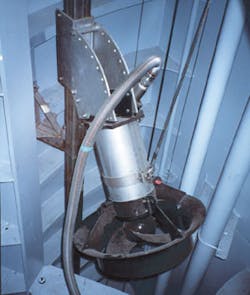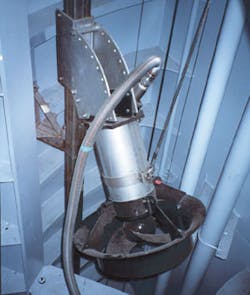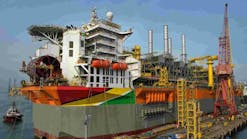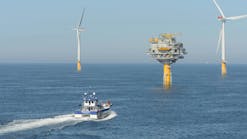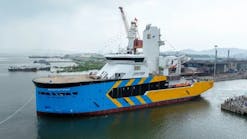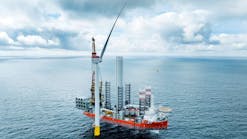Submersible agitators from ITT Flygt are to be installed on six drilling rigs under construction for Maersk Contractors (four semi-submersibles and two jackups). In volume terms the order is one of ITT Flygt’s largest for the offshore sector, with mixers to be installed in all the drilling fluid tanks in the semis, and in storage tanks in the jackups.
Deliveries will be phased over 2006-07. ITT Flygt will supply SR 4660 and SR 4680 units, the biggest selling agitators from its SR 4600 range for drilling fluid applications. Maersk Contractors first ordered the company’s submersible agitators in 2001 for its newbuild jackups XL1 and XL2, followed by a second batch in 2002 for the newbuild semiMaersk Explorer.
ITT Flygt is the only supplier with submersible agitators on mobile drilling rigs, says Fredrik Nyrén, marketing manager for the company’s industrial business unit. It is also a leading provider of submersible agitators to supply boats, with 4-5,000 units installed. Demand remains strong, with the newbuild rig and supply vessel sector still booming.
Constant motion
Drilling fluids must be kept in motion from the time they are originally mixed, otherwise the heavier components will settle at the bottom of the tank. They are usually mixed onshore and transported to the drilling rig by supply vessel. Once on the rig they are likely to spend some time in the storage tanks before being transferred to the active tanks when required for use downhole. After their journey downhole, they are separated from the drill cuttings and passed to the return tank, ready to be recirculated.
While in transit on the vessel, and while waiting to be used or reused on the rig, the drilling fluid has to be agitated. Often additional ingredients are added on the rig to adjust it for the specific downhole conditions.
Drilling fluid often has a high density, but may also have a high yield stress, meaning that it does not flow easily. In some cases several agitators may be required to provide sufficient agitation.
ITT Flygt supplies submersible agitators for use in drilling fluid tanks on drilling rigs - as pictured - and supply vessels.
Downhole conditions determine the drilling fluid composition required, Nyrén says. For example, the fluid for North Sea wells is generally relatively easy to mix, while that for Gulf of Mexico drilling is much tougher. Agitators must therefore be built to a heavy-duty design which is both reliable and easy to service.
Flexibility
The main benefit of the submersible agitators is flexibility of location. They are easy to place in the optimal location and orientation, in contrast to externally driven agitators, which are usually in a fixed location. Working from specifications provided by the client, ITT Flygt has programs for calculating the optimal location for the agitators given the shape of the tank and the characteristics of the drilling fluid. Being able to make these calculations is important as, due to space constraints both on rigs and supply ships, tanks often have shapes not ideally suited for mixing.
ITT Flygt likes to become involved during the rig or vessel design stage, Nyrén says. Given accurate information by the client on the tank shape and dimensions, and characteristics of the drilling fluid, it is able to specify the optimal agitator for the job, thus providing the most cost-effective solution.
On drilling rigs the ITT Flygt agitator can be installed using a guide-bar system and lowered into the tank by means of a davit. It can be easily placed at different depths and orientations, and equally easily retrieved for inspection and service. Because the propellers of externally driven agitators are usually fixed in place, the drilling fluid has to be drained from the tank to provide access when a service is needed. Another difference is that submersible agitators are silent in operation, which makes for a more comfortable working environment.
Space saving
Outside the tank the submersible agitators take up a minimum of space, and do not require the headroom for installation and retrieval taken up by traditional long-shaft mixing units.
ITT Flygt has supplied submersible agitators to the offshore industry since the 1980s. The propeller of the SR 4600 range has three double-curved blades for maximum efficiency. The blades can be welded to the hub at different angles to provide different mixing capabilities. A jet-ring mounted around the propeller increases the hydraulic efficiency, thus enabling power consumption to be reduced. The jet-ring can also be configured to provide flow past the motor, thus ensuring cooling even in the case of highly gelled drilling fluids.
Double-acting shaft seals, designed and manufactured by ITT Flygt specifically for its submersible equipment, are combined into one, rigid plug-in unit which protects the motor from media intrusion. The seal housing contains barrier fluid which also lubricates and cools the seal. The company also designs and manufactures its own motors for use with its submersible agitators. These are built to a multipole squirrel cage design. The motor shaft is supported by one main bearing at the propeller end and a double bearing at the rear end.•
For more information contact Fredrik Nyrén, ITT Flygt. Tel +46 8 475 6952, fax +46 8 475 6900. [email protected], www.flygt.com.
